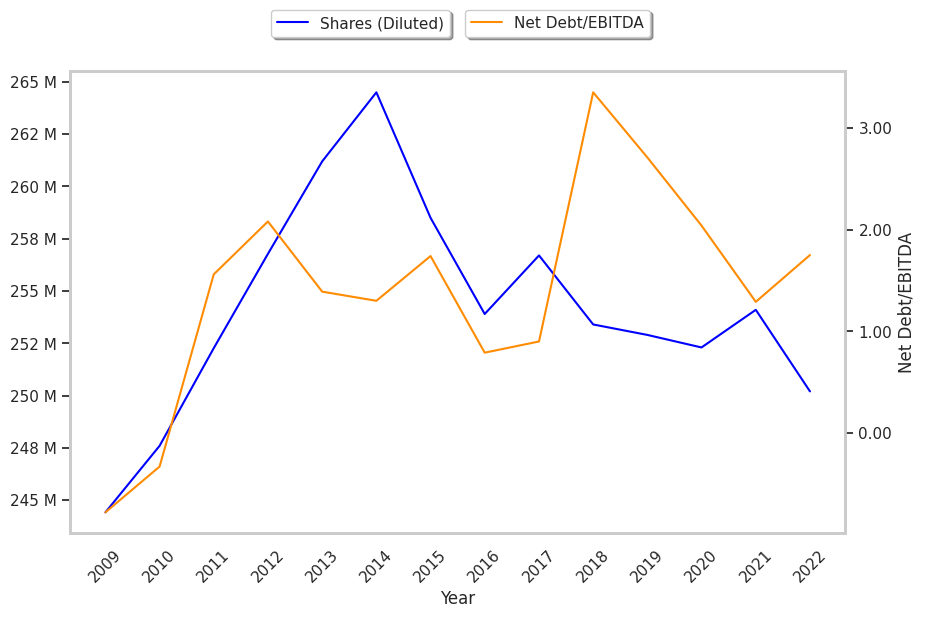Trimble does not have the profile of a defensive investment based on the requirements of Ben Graham. The Farm & Heavy Construction Machinery firm may nonetheless be of interest to more risk-oriented investors who have a solid thesis on the company's future growth. At Market Inference, we remain agnostic as to such further developments, and prefer to use a company's past track record as the bellwether for future potential gains.
Trimble Is Probably Overvalued
Graham devised the below equation to give investors a quick way of determining whether a stock is trading at a fair multiple of its earnings and its assets:
√(22.5 * 6 year average earnings per share (1.48) * 6 year average book value per share (17.444) = $25.6
At today's price of $52.01 per share, Trimble is now trading 103.1% above the maximum price that Graham would have wanted to pay for the stock.
Even though the stock does not trade at an attractive multiple, it might still meet some of the other criteria for quality stocks that Graham listed in Chapter 14 of The Intelligent Investor.
Positive Retained Earnings From 2010 To 2022, No Dividend Record, and Eps Growth In Excess Of Graham'S Requirements
Ben Graham wrote that an investment in a company with a record of positive retained earnings could contribute significantly to the margin of safety. Trimble had positive retained earnings from 2010 to 2022 with an average of $1.26 Billion over this period.
Another one of Graham's requirements is for a 30% or more cumulative growth rate of the company's earnings per share over the last ten years.To determine Trimble's EPS growth over time, we will average out its EPS for 2009, 2010, and 2011, which were $1.14, $0.29, and $1.20 respectively. This gives us an average of $0.88 for the period of 2009 to 2011. Next, we compare this value with the average EPS reported in 2020, 2021, and 2022, which were $1.11, $1.94, and $1.80, for an average of $1.62. Now we see that Trimble's EPS growth was 84.09% during this period, which satisfies Ben Graham's requirement.
We have no record of Trimble offering a regular dividend.
Negative Current Asset to Liabilities Balance and Not Enough Current Assets to Cover Current Liabilities
Graham sought companies with extremely low debt levels compared to their assets. For one, he expected their current ratio to be over 2 and their long term debt to net current asset ratio to be near, or ideally under, under 1. Trimble fails on both counts with a current ratio of 1.0 and a debt to net current asset ratio of -0.7.
Conclusion
According to Graham's analysis, Trimble is likely a company of average quality, which does not offer a significant enough margin of safety for a risk averse investor.
| 2018-02-27 | 2019-02-22 | 2020-02-28 | 2021-02-26 | 2022-02-23 | 2023-02-17 | |
|---|---|---|---|---|---|---|
| Revenue (MM) | $2,646 | $3,108 | $3,264 | $3,148 | $3,659 | $3,676 |
| Gross Margins | 52.0% | 54.0% | 55.0% | 56.0% | 56.0% | 56.0% |
| Operating Margins | 9% | 10% | 12% | 14% | 16% | 15% |
| Net Margins | 4.0% | 9.0% | 16.0% | 12.0% | 13.0% | 12.0% |
| Net Income (MM) | $118 | $283 | $514 | $390 | $493 | $450 |
| Net Interest Expense (MM) | -$25 | -$73 | -$82 | -$78 | -$65 | -$71 |
| Depreciation & Amort. (MM) | -$183 | -$215 | -$207 | -$198 | -$180 | -$172 |
| Earnings Per Share | $0.46 | $1.12 | $2.03 | $1.55 | $1.94 | $1.8 |
| EPS Growth | n/a | 143.48% | 81.25% | -23.65% | 25.16% | -7.22% |
| Diluted Shares (MM) | 257 | 253 | 253 | 252 | 254 | 250 |
| Free Cash Flow (MM) | $473 | $554 | $654 | $729 | $797 | $434 |
| Capital Expenditures (MM) | -$44 | -$68 | -$69 | -$57 | -$46 | -$43 |
| Net Current Assets (MM) | -$590 | -$2,012 | -$2,308 | -$1,997 | -$1,704 | -$1,701 |
| Long Term Debt (MM) | $786 | $1,712 | $1,624 | $1,291 | $1,293 | $1,220 |
| Net Debt / EBITDA | 0.9 | 3.35 | 2.71 | 2.04 | 1.29 | 1.75 |



